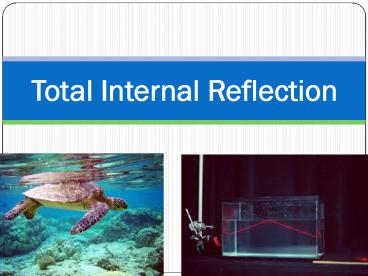Total Internal Reflection - PowerPoint PPT Presentation
1 / 11
Title: Total Internal Reflection
1
Total Internal Reflection
2
Critical Angle
- Critical Angle (ltc) The term used to describe
an angle of incidence that produces an angle of
refraction of 90o. - When the angle of refraction reaches 90o, the
refracted ray will lie along the boundary between
two media (such as water and air).
3
Total Internal Reflection
- Total Internal Reflection When the angle of
incidence is larger than the critical angle,
there is no refraction from one medium to
another. All of the light is reflected back to
the first medium. - Only occurs when light travels from a medium in
which the speed of light is lower to a medium in
which the speed of light is higher.
4
(No Transcript)
5
(No Transcript)
6
Phenomenon of Total Internal Reflection
7
Binoculars and Total Internal Reflection
- Binoculars consist of three main parts
- Convex Lenses To magnify the image.
- Eyepiece Brings the image into focus and makes
it visible to the eye. - Two Prisms The prisms used for binoculars are
shaped like isosceles right triangles, which
changes the direction of the light ray by 90o.
8
How Prisms Work in Binoculars
- Light first enters perpendicular to one of the
short sides, producing an angle of incidence of
zero. Thus, no refraction at this surface occurs
and it goes straight through to hit the long
side. - At the long side, the both the angle of incidence
and reflection is 45o, changing the direction of
the light by 90o each time. Thus, the total
change in direction is 180o.
9
How Prisms Work in Binoculars
10
Optical Fibers and Total Internal Reflection
- Optical fibers are long, thin strands of very
pure glass that are arranged in bundles called
optical cables and used to transmit light signals
over long distances. - Parts of an Optical Fiber
- Core - Thin glass center of the fiber where the
light travels. - Cladding - Outer optical material surrounding the
core that reflects the light back into the core.
The cladding must have a lower index of
refraction than the core. - Buffer coating - Plastic coating that protects
the fiber from damage and moisture.
11
Optical Fibers and Total Internal Reflection
- Hundreds or thousands of optical fibers are
arranged in bundles to make up optical cables. - When light enters the fiber and hits the boundary
between the core and the cladding at an angle
larger than the critical angle, total internal
reflection occurs along the entire fiber until it
reaches the end.































